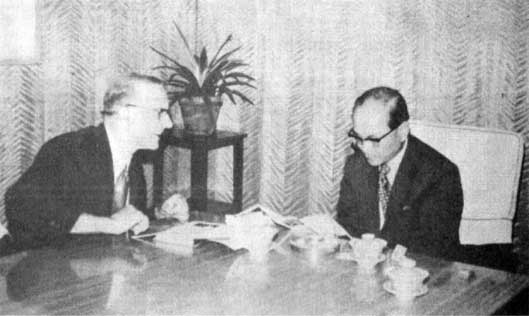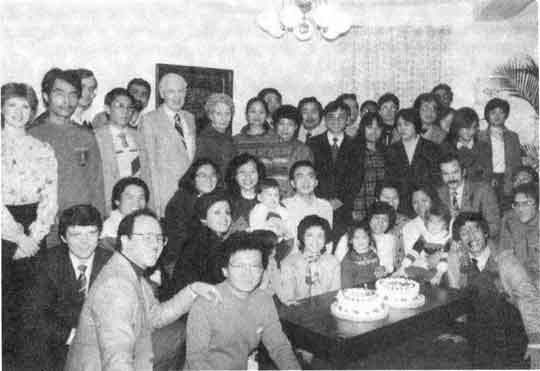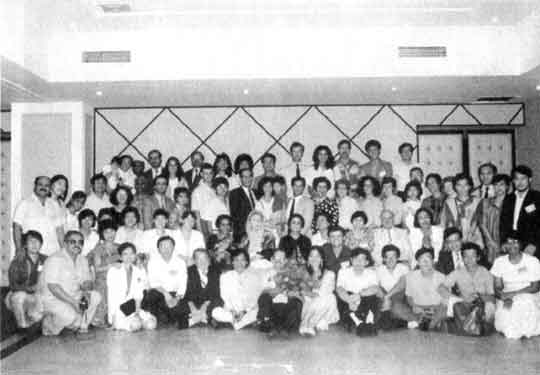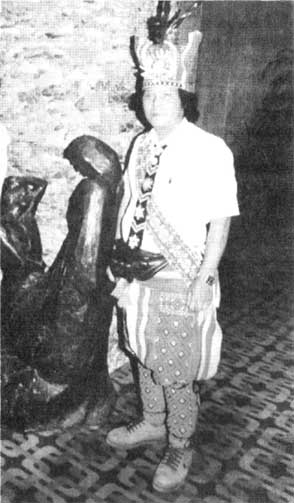
|
Taiwan Bahá'í Chronicle:
An Historical Record of the Early Days of the Bahá'í Faith in Taiwan
by Barbara R. Sims
 |
chapter 22 | start page | single page |
Chapter 23
23. Some Events in the Later Years
 |
| (click for larger picture) |
A Certificate of Registration of the National Spiritual Assembly of the Bahá'ís of Taiwan, issued by the government, December 8, 1970.
58

Hand of the Cause Collis Featherstone is shown presenting Bahá'í literature to Mr. Henry Kao, Mayor of Taipei, May 1972.

Mr. Suleiman A. Suleimani is shown accepting an award from His Excellency Lee Teng-Hui, the governor of Taiwan, May 28, 1982. The award honored Mr. Suleimani's "contribution to the religious welfare of the people of Taiwan". The presentation was made in a ceremony before an audience of 1,000 people. Awards were also given to representatives of several other major religions. Mr. Lee later became President of the Republic of China.
59
 |
| (click for larger picture) |
Universal House of Justice member Mr. Hugh Chance with his wife Mrs. Margaret Chance visited Taiwan briefly in 1983, greatly encouraging the friends. They are standing in front of the picture frame. Kneeling at the right hand of Mr. Chance is Mr. David Huang who was the first Chinese appointed Counsellor for Taiwan.
60
 |
| (click for larger picture) |
Amatu'l-Bahá Rúhiyyih Khánum (in the center wearing a white veil) in Taiwan, August 1988, at an Auxiliary Board Conference. Also present were three Counsellors, Mrs. Shanta Sundrum (to the left of Rúhiyyih Khánum), Mr. Bijan Farid (top row, fifth from the left wearing glasses) and Mr. Rouhollah Mumtazi (second row second from the right).
61

The Chief of the Beinan (Puyuma) Tribe, Mr. Chen Wen-sheng, accepted the Faith in 1990. He was the first tribal chief of an indigenous people in Taiwan (and greater China) to become a Bahá'í. His son, Mr. Chen Chien-hong, the next hereditary chief also accepted the Faith at the same time. Chief Chen is shown here in tribal dress in the Holy Land in 1992 when he attended ceremonies commemorating the one hundredth Anniversary of the Ascension of Bahá'u'lláh.
62
Names
Tsao Yun-siang
early Bahá'í in mainland China; translated several books including Bahá'u'lláh and the New Era into Chinese in the 1930s; he was never in Taiwan to our knowledge.
Chu Yao-lung (Jerome)
born on the Chinese mainland; declared in the United States in 1947; moved to Taiwan in 1949; thought to be the first resident believer in Taiwan; on the first Local Spiritual Assembly of Tainan, 1956.
Tsao Li-shih
declared in 1953 through Hand of the Cause Mr. Khádem; on the first Local Spiritual Assembly of Tainan, 1956.
Hong Li-ming (Jimmy)
declared in 1953 through Hand of the Cause Mr. Khádem; the first Taiwan-born person to become a Bahá'í; on the first Local Spiritual Assembly of Taipei, 1958.
Wong Ho-len
resided in Tsoying; declared in 1953 through Hand of the Cause Mr. Khádem.
Chien Tien-li, Cheng or Chang Tien-lee, Lee Chang
declared in the United States; moved to Taiwan in 1949; one of the first Chinese to have a Bahá'í marriage (in Denver, Colorado, U.S.A. in the middle or late 1940s).
Yuan Mien-hsien (Mason)
declared in the United States in 1947; moved to Taiwan in 1949; on the first Local Spiritual Assembly of Taipei, 1958.
Yuan Hsu-chang, Yuan Chui-chang
on the first Local Spiritual Assembly of Taipei, 1958; originally from Nanking; declared there through Mr. Chu in the late 1940s; moved to Taiwan in 1949.
Wang Tzu-nan (Gellan)
declared in United States in 1947; on the first Local Spiritual Assembly of Taipei, 1958.
63
resided in Kangshan and Taipei; declared May 1955; on the first Local Spiritual Assembly of Taipei, 1958; withdrew from the Faith several years later.
Ho Cheng-tzu, Ho Chung-tzu
resided in Chia-yi and Tainan; declared Naw-Rúz 1955; on the first Local Spiritual Assembly of Tainan, 1956; designed the Tainan Bahá'í Center.
Tu Guan-chiao (Ruthy)
the first woman to declare in Taiwan, 1955; on the first Local Spiritual Assembly of Tainan, 1956.
Wang Chi-chang
on the first Local Spiritual Assembly of Tainan, 1956.
Pai Chung-cheng, Pai Chung-chien
declared Naw-Rúz 1955; on the first Local Spiritual Assembly of Tainan, 1956.
Luk Yun-shen (Winston)
originally from Canton; declared in 1955; on the first Local Spiritual Assembly of Tainan, 1956.
Cheng Chung-chan, Cheng Chen-chang
resided in Taipei; declared Naw-Rúz 1955.
Hsiao (Siao) Tsan-chang (Johnson)
resided in Chia-yi and Taipei; declared Naw-Rúz 1955; on the first Local Spiritual Assembly of Taipei, 1958.
Tai Tung-ko
early Bahá'í of Tsoying, before 1955.
Yim Pui-foung, Yen P'ei-feng (Harry)
the first Chinese Bahá'í in Macau, 1954.
Anthony Seto [no image]
the first Chinese-American Bahá'í; he and his American wife pioneered to Hong Kong in 1954; he died in Japan in 1957 after attending the first National Convention of North East Asia.
Ni Jun-chung
became a Bahá'í in 1955; he was on the first Local Spiritual Assembly of Tainan, 1956; withdrew from the Faith some years later.
64
became a Bahá'í in Macau, 1955; translated an early prayer book into Chinese; became a Knight of Bahá'u'lláh for opening Hainan Island, 1959.
Shen Chien
resided in Chia-yi; became a Bahá'í at Summer School in 1957.
Huang Hsi
resided in Chia-yi; introduced Mr. Shen to the Faith.
Wang Pu-cheng (Pershing)
declared in 1958; on the first Local Spiritual Assembly of Taipei, 1958.
Wang P'u-sheng (Steven)
brother of Pershing Wang; first youth to enroll in Taipei, 1960.
Wu Pin-chen
the first Bahá'í in Pingtung; on the first Local Spiritual Assembly of Pingtung,
1966.
Mrs. Kao (Yang Su-su)
Yang Su-thou
Yeh Chon-ching [no image]
Mr. Yang and Miss Yeh had the first Bahá'í marriage in Taiwan, 1963.
Liu Chan-song
early Bahá'í in mainland China; translated much literature into Chinese; he was never in Taiwan to our knowledge.
Hung Bao-fung
first declared believer in Kaoshiung, 1965.
Jean Cheng, Cheng Mei Jean
a member of the Local Assembly of Tainan, 1964; she introduced Miss Hung to the Faith.
Yankee Leong
the first Chinese-Malaysian believer; first Counsellor of Chinese ancestry.
Leong Tat Chee
early Chinese-Malaysian believer; Auxiliary Board Member; with Yankee Leong travel-taught throughout the Orient.
65
early Bahá'í (1966) belonging to the Ami tribe.
Yeh Chin-hsing (Jason) [no image]
the first Bahá'í to die in Taiwan, 1965.
Mrs. Wu Ping-chen
Chung Ching-tan
Wu Wen-jen
Lee Liang-tung
Wang Ching-ian
Chiu Chung-shao
Huang Ha-tan
Wen Lung-fui
above mentioned eight names, along with Mr. Wu Ping-chen who is listed earlier, were members of the first Local Spiritual Assembly of Pingtung, 1966.
Lin Fang-nan (Mark)
resided in Hsing-Tien, enrolled in March 1965; had meetings in his house for Hand of the Cause Mr. Samandari, 1966.
Yen Chih-hsiung (Robert)
Kuo Rong-hui (Peter)
Tsao Kai-min
Wang Tseng-min, Huang Tsen-min
Huang Ting-sheng
the above five persons were elected to the first National Spiritual Assembly of Taiwan, 1967. Mr. Wang Tseng-min (Huang Tsen-min) was also on the second National Assembly, 1968.
Kit Yin-kiang, Ji Sheng-jiang
pioneer to Taiwan from Malaysia in 1967; elected to the first National Spiritual Assembly in a by-election, 1967; also on the second National Assembly, 1968.
Lin Yi-mou
delegate to the first Convention; elected to the first National Spiritual Assembly in a by-election, 1967; also elected to the second National Spiritual Assembly, 1968.
Elizabeth Yen
elected to the first National Spiritual Assembly in a by-election, 1967; also elected to the second National Assembly, 1968.
66
elected to the first National Spiritual Assembly in a by-election, 1967.
Yu (Yiu) Hsih-ho
present at the first Convention; delegate to the second and elected to the second National Spiritual Assembly, 1968.
Loren Dzen
delegate to both the first and the second Convention.
Peng (Perng) Fu-fa
present at the first Convention; delegate to the second.
Hung (Hong) Hoh-tsu
delegate to the first Convention.
Chen Ron-hsen
delegate to the second Convention.
Major Liang
delegate to the second Convention.
Kuan Ku
delegate to the second Convention.
Chen Wen-sheng
Chief of the Beinan (Puyuma) Tribe.
Chen Chien-hong
son of Chief Chen Wen-sheng; the next hereditary chief of the Beinan Tribe.
67
Afterword
The first Chinese believers in Taiwan were brought into the Faith by American Bahá'ís while studying or training in the United States during the late 1940s. However, the first pioneers to Taiwan were Iranian Bahá'ís, Mr. Suleiman A. and Mrs. Ridvaniyyih Suleimani. This devoted couple spent most of their lives serving the Chinese, on the mainland and in Taiwan.
In 1958 the American pioneers, Mr. Keith and Mrs. Edith Danielsen-Craig, arrived. They were followed in the 1960s by other Americans: Mr. Dale and Mrs. Barbara Enger, Mr. Charles Duncan, Mr. John Huston, Mr. Charles and Mrs. Wynn Bush, Mr. Henry Jarvis, Dr. Sidney and Mrs. Isabel Dean, Mrs. Abbie Maag and Mr. and Mrs. Harvey Redson. Mrs. Mehri Molin, an Iranian, played a prominent part in the 1960s. Some of the travel-teachers in those early days include Mr. Jack Davis, who in later years settled in Taiwan, Mr. Carl and Mrs. Loretta Scherer, Mr. Muhammad Labib, Mr. G.V. Tehrani, Dr. William Maxwell, Miss Tyshon Clark (Davis), Mrs. Orpha Daugherty, Dr. David and Mrs. Joy Earl, Mr. Noureddin and Mrs. Behjat Mumtazi, Mr. Rouhollah Mumtazi, Miss Agnes Alexander, Mrs. Barbara Sims and Miss Ruth Walbridge. The Malaysian Bahá'ís Mr. Yankee Leong and Mr. Leong Tat Chee visited as well, and the first Malaysian pioneer, Mr. Kit Yin-kiang, arrived in 1967 and is still at his post (1994). There were other pioneers and travel teachers through the later years.
Many years have passed since the times of which we have written. The principal figures, whether Chinese or pioneers, have, for the most part, gone.
This is mainly a chronology with photos that we could find to accompany it. The purpose of this chronicle is, of course, to preserve the past as much as possible for the future generations.
Interestingly enough, most of the research was done in the extensive files of the National Bahá'í Archives of the National Spiritual Assembly of Japan, archives which were inherited from the National Spiritual Assembly of North East Asia and some of which were collected by the compiler. Taiwan (Formosa) was under the jurisdiction of the National Spiritual Assembly of North East Asia from its formation in 1957 until 1967 when the National Spiritual Assembly of Taiwan was elected. We also spent several days going through the archives held at the Bahá'í National Office in Taipei, Taiwan, whose staff was very helpful, while other friends kindly supplied recollections and photos. The Taipei records included
68
If this chronical is devoid of assessment, critique or analysis, it is because the compiler felt she could not do more than supply a chronology with as many details as possible and as many photos as she could find that contributed to the text.
The correct transliteration of names caused problems for the compiler as did the proper Chinese written characters. Some of the latter were unrecorded, hence unavailable. Thanks to much sleuthing through files and photos and the help of the friends in Taiwan we have decided upon the proper, or most familiar, transliteration and have indentified a good number of written characters. Consequently there is a special section at the end for names. The discovery of each character represented a victory, as in those early days correspondence was carried out in English and often the Chinese involved gave themselves anglicized first names with simplified or arbitrary spellings of family names so as to make it easier for their foreign friends — albeit more difficult for historians!
We could not find photos of Hands of the Cause Mr. Kházeh or Mr. Faizi which were taken while they were in Taiwan; however, we were able to find at least one photo of all the other Hands of the Cause who visited.
Barbara R. Sims
Tokyo, Japan, 1994
69
Bibliography
- Bahá'í World Volumes XII, XV, XVII, XVIII
- Bahá'í News' of the 1950s and 1960s
- Malaysian Bahá'í News, September 1966, June 1967
- Letters, reports, documents and photographs from the National Bahá'í Archives of Japan and the National Bahá'í Archives of Taiwan; photographs from the National Bahá'í Archives of the United States; photographs from individual collections; photographs and a chronology of events sent by the Department of Library and Archival Services at the Bahá'í World Centre, Haifa.
- The Six Year Plan — Summary of Achievements (1993)
 |
chapter 22 | start page | single page |
|
|